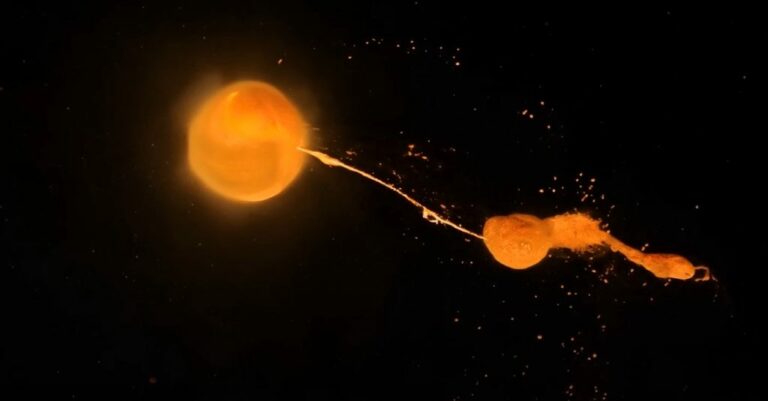The Moon’s formation could have occurred within a few hours following a colossal collision with Earth (video).
The Moon has been a constant companion to Earth since ancient times. However, the relationship between Earth and the Moon has not always been the same as it is today.
Approximately 4.5 billion years ago, during the formation of the solar system, Earth did not have a Moon orbiting around it. It was during this time that a large celestial body, similar in size to Mars and known as Theia, collided with Earth. This collision, according to the widely accepted Giant Impact Hypothesis, led to debris being scattered around Earth, eventually coming together to form the Moon.
Despite the popularity of this theory, there are some challenges, especially concerning the composition of lunar rocks. When samples were brought back from the Moon by Apollo astronauts, scientists found that the isotopic signatures of these rocks closely matched those of Earth’s mantle. This similarity indicates that a significant portion of the Moon’s material originated from Earth.
While the traditional Giant Impact Hypothesis suggests that most of the debris that formed the Moon came from Theia, alternative explanations have struggled to explain the Moon’s current orbit.
Recent simulations carried out by researchers from Durham University’s Institute for Computational Cosmology propose a revised scenario. These simulations indicate that the Moon may have formed shortly after the collision with Theia, possibly within a few hours, which is much faster than previously thought.
Lead researcher Jacob Kegerreis stated, “This discovery presents a whole new range of potential starting points for the Moon’s development.” Their findings were published in the Astrophysical Journal Letters.
The research team conducted around 400 simulations of the Theia-Earth collision using smoothed particle hydrodynamics, a method that models particle behavior under both gravity and pressure. In contrast to previous simulations that utilized hundreds of thousands to millions of particles, these new simulations utilized up to a hundred million particles, providing an unprecedented level of detail.
The high-resolution simulations uncovered behaviors that were previously overlooked in lower-resolution models. Kegerreis pointed out, “Standard resolutions can lead to misleading conclusions.” Additionally, the simulations resulted in a Moon with features like a wide orbit and a partially solid interior, offering potential explanations for the Moon’s tilted orbit and thin crust.
Despite these advancements, the simulations still do not fully account for the isotopic similarities between Earth and the Moon. Even with 60 percent of the Moon’s material originating from Earth, there remains a discrepancy in isotopic composition.
Robin Canup, from the SwRI Space Science and Engineering Division, elaborated, “Even a clump with 60 percent protoEarth material, along with the rest from Theia, would still be expected to result in a much larger Earth-Moon isotopic difference than what we observe.”
While the simulations indicate that material from both Earth and Theia may not have completely mixed during the Moon’s formation, Canup views this as unlikely. She explained, “For any part of the Moon that forms intact, there is no chance for mixing between the protolunar and post-impact Earth material to eliminate such compositional differences.”
To uncover the details of the Moon’s formation, it is essential to conduct further analysis on lunar rocks, especially those from unexplored areas and below the surface. By integrating data gathered from these missions with simulations, scientists aim to solve the puzzle of how the Moon was created around Earth billions of years ago.
Studying the origins of the Moon not only illuminates Earth’s past but also offers valuable insights into the development of other celestial bodies impacted by similar cosmic events. According to Vincent Eke, a researcher at Durham University, “The more we understand about the Moon’s origins, the more we learn about the evolution of our own planet.”
Do not forget to share your opinion with us to provide you with the best posts !




0 Comments